1995 CHEVROLET CORVETTE manual transmission
[x] Cancel search: manual transmissionPage 353 of 386

Downloaded from www.Manualslib.com manuals search engine Maintenance Schedule I1 I
82,500 Miles (137 500 km)
0 Change engine oil and filter (or every
12 months, whichever occurs first).
17 Lubricate the suspension, steering and
An Emission Control Service. *
transmission shift linkage, parking brake
cable guides, underbody contact points and
linkage (or every
12 months, whichever
occurs first).
~~ ~
DATE SERVICED BY: ACTUAL MILEAGE
I
90,000 Miles (150 000 km)
0 Change engine oil and filter (or every
12 months, whichever occurs first).
An Emission Control Service.
0 Lubricate the suspension, steering and
*
transmission shift linkage, parking brake
cable guides, underbody contact points and
linkage (or every 12 months, whichever
occurs first).
every 24 months, whichever occurs first).
An Emission Control Service.
0 Change automatic transmission fluid and
filter
if the vehicle is mainly driven under
one or more
of these conditions:
- In heavy city traffic where the outside 2 q'.,
0 Inspect engine accessory drive belt (or
temperature regularly reaches
90 OF
(32 O C) or higher.
7-38
Page 354 of 386
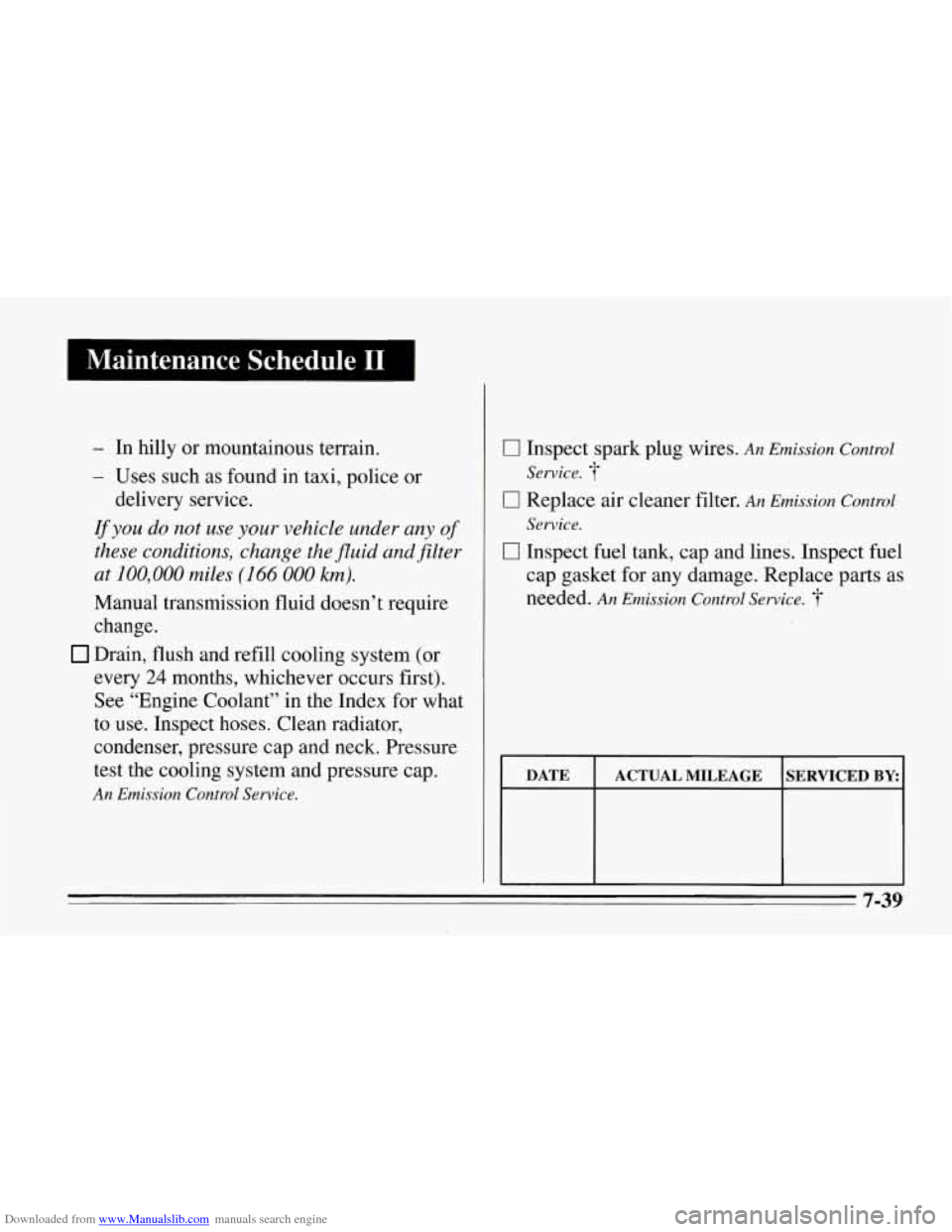
Downloaded from www.Manualslib.com manuals search engine 1 Maintenance Schedule I1
- In hilly or mountainous terrain.
- Uses such as found in taxi, police or
If you do not use your vehicle under any of
these conditions, change the fluid and filter
at
100,000 miles (1 66 000 km).
Manual transmission fluid doesn’t require change.
Drain, flush and refill cooling system (or
every
24 months, whichever occurs first).
See “Engine Coolant’’ in the Index
for what
to use. Inspect hoses. Clean radiator,
condenser, pressure cap and neck. Pressure
test the cooling system and pressure cap.
delivery service.
An
Emission Control Service.
0 Inspect spark plug wires. An Emission Control
0 Replace air cleaner filter. An Emission Control
0 Inspect fuel tank, cap and lines. Inspect fuel
cap gasket for any damage. Replace parts as
needed.
An Emission Control Service.
Service.
Service.
7-39
Page 355 of 386

Downloaded from www.Manualslib.com manuals search engine I Maintenance Schedule I1
97,500 Miles (1 62 500 km)
0 Change engine oil and filter (or every
12 months, whichever occurs first).
0 Lubricate the suspension, steering and
An Emission Control Service. *
transmission shift linkage, parking brake
cable guides, underbody contact points and
linkage
(or every 12 months, whichever
occurs first).
100,000 Miles (166 000 km)
0 Replace spark plugs. An Emission Control
Service.
0 If you haven’t used your vehicle under
severe service conditions listed previously
and, therefore, haven’t changed your
automatic transmission fluid, change both
the fluid and filter.
DATE SERVICED BY ACTUAL MILEAGE
7-40
Page 357 of 386

Downloaded from www.Manualslib.com manuals search engine At Least Once a Year
Key Lock Cylinders
Lubricate the key lock cylinders with the lubricant
specified in Part
D.
Body Lubrication
Lubricate all body door hinges. Also lubricate all hinges
and latches, including those for the hood, rear compartment,
console door and any folding seat hardware. Part
D tells
you what
to use. More fiequent lubrication may be required
when exposed to a corrosive environment.
Starter Switch
NOTE: Do not use the accelerator pedal, and be
ready to turn off the engine immediately if it starts.
3. On automatic transmission vehicles, try to start the
engine in each gear. The starter should work only in
PARK
(P) or NEUTRAL (N). If the starter works in
any other position, your vehicle needs service.
On manual transmission vehicles, put the shift lever
in NEUTRAL
(N), push the clutch down halfway
and
try to start the engine. The starter should work
only when the clutch is pushed down all the way to
the floor. If the starter works when the clutch isn’t
pushed all the way down, your vehicle needs service.
Brake-l’ransmission Shift Interlock -- BTSI
(Automatic Transmission)
1. Before you start, be sure you have enough room
2. Firmly apply both the parking brake (see “Parking
around
the vehicle.
Brake” in the Index
if necessary) and the regular brake.
1. Before you start, be sure you have enough room around
the vehicle. It should
be parked on a level surface.
7-42
Page 358 of 386
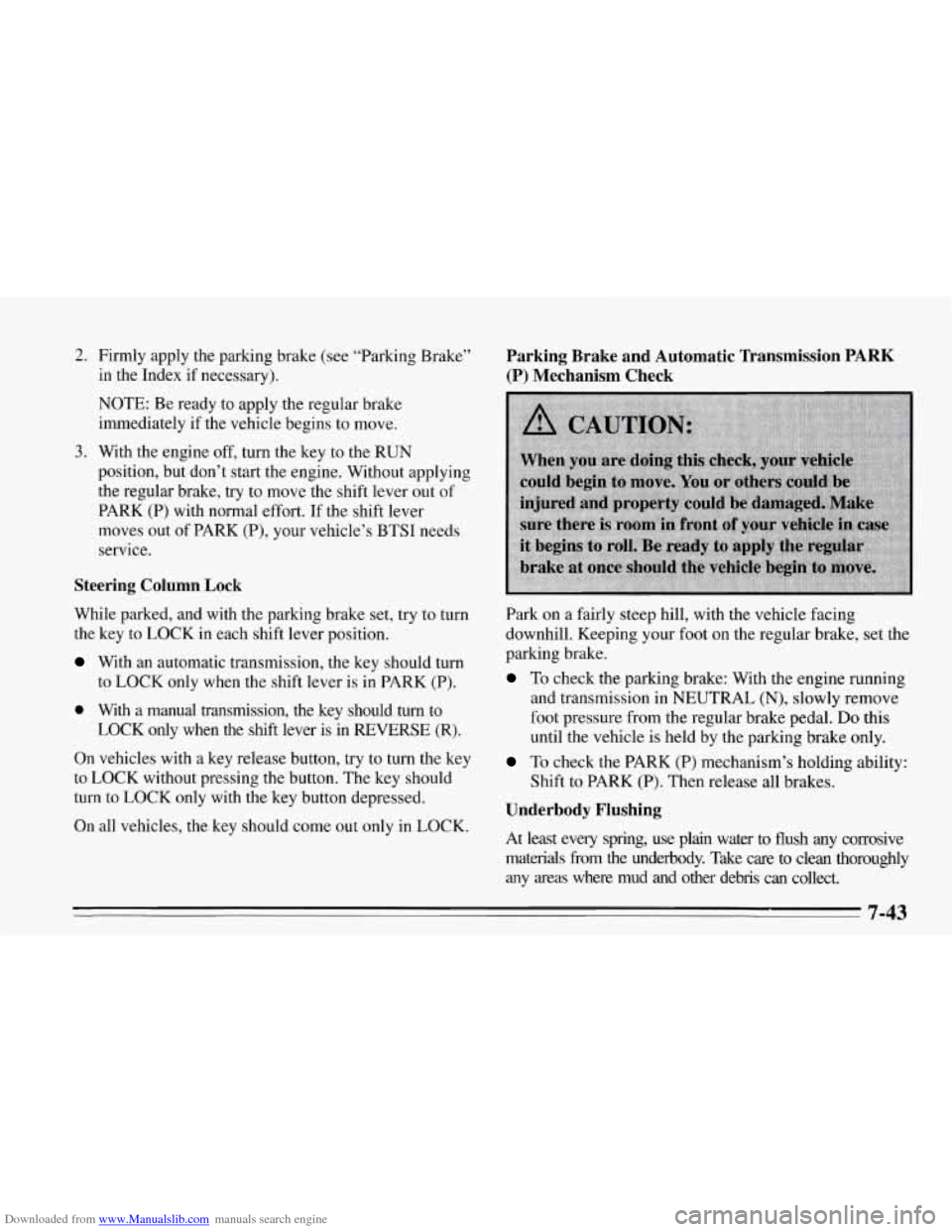
Downloaded from www.Manualslib.com manuals search engine 2. Firmly apply the parking brake (see “Parking Brake”
in the Index if necessary).
Parking Brake and Automatic Transmission PARK
(P) Mechanism Check
3.
NOTE: Be ready to apply the regular brake
immediately if the vehicle begins to move.
With the engine off, turn the key
to the RUN
position, but don’t start the engine. Without applying
the regular brake, try to move the shift lever out
of
PARK (P) with normal effort. If the shift lever
moves out of PARK (P), your vehicle’s BTSI needs
service.
Steering Column Lock
While parked, and with the parking brake set, try to turn
the key to LOCK in each shift lever position.
With an automatic transmission, the key should turn
to LOCK only when the shift lever is in PARK
(P).
0 With a manual transmission, the key should turn to
LOCK only when the shift lever is in REVERSE (R).
On vehicles with
a key release button, try to turn the key
to LOCK without pressing the button. The key should
turn to LOCK only with the key button depressed.
On all vehicles, the key should come out only in LOCK. Park on a fairly
steep hill, with the vehicle facing
downhill. Keeping your foot on the regular brake, set the
parking brake.
To check the parking brake: With the engine running
and transmission in NEUTRAL
(N), slowly remove
foot pressure from the regular brake pedal.
Do this
until the vehicle is held by the parking brake only.
To check the PARK (P) mechanism’s holding ability:
Shift to PARK (P). Then release all brakes.
Underbody Flushing
At least every spring, use plain water to flush any corrosive
materials from the underbody. Take care to clean thoroughly any areas where mud and other debris can collect.
7-43
Page 359 of 386
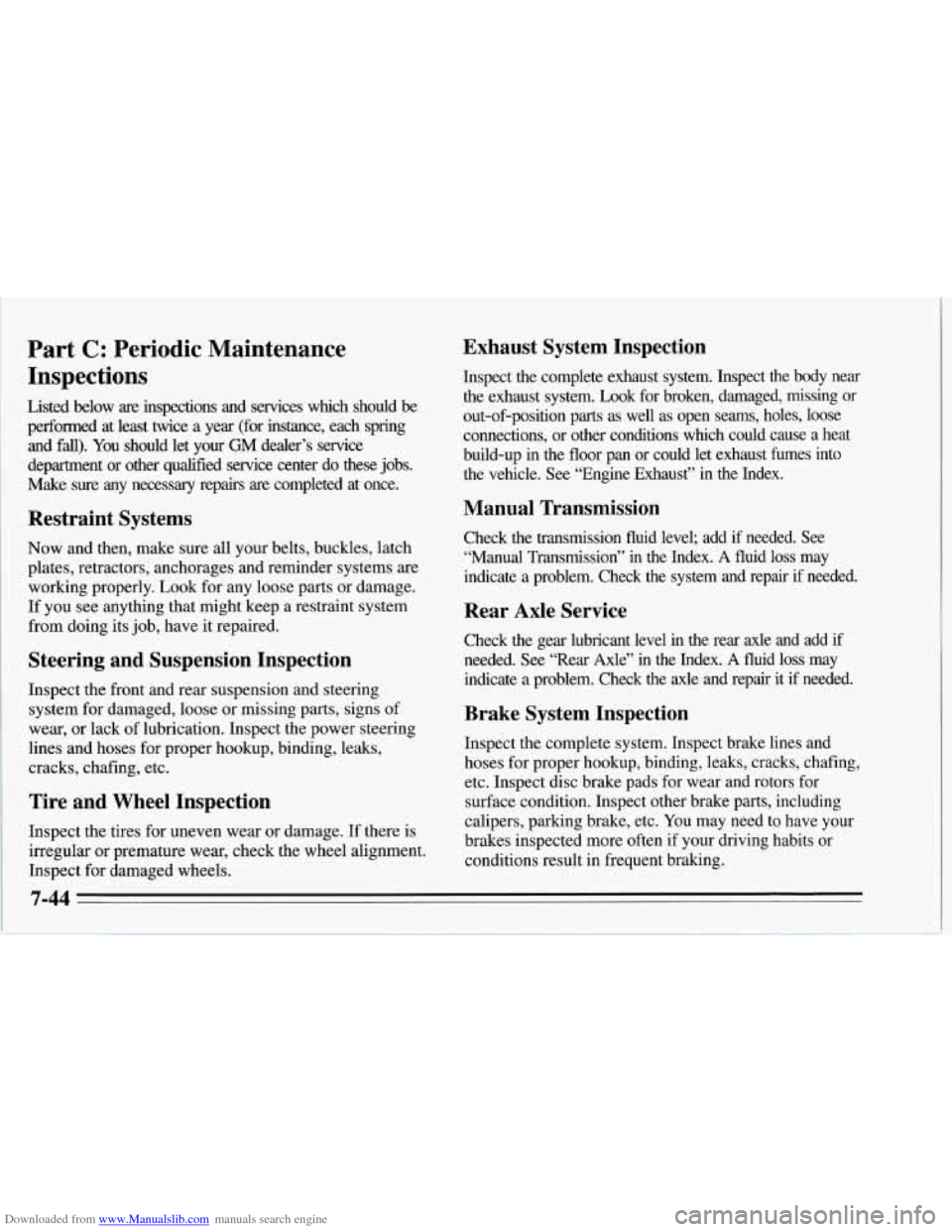
Downloaded from www.Manualslib.com manuals search engine Part C: Periodic Maintenance
Inspections
Listed below are inspections and services which should be
performed at least twice a year (for instance, each spring
and fall). You should let your GM dealer’s service
department or other qualified service center do these jobs.
Make sure any necessary repairs
are completed at once.
Restraint Systems
Now and then, make sure all your belts, buckles, latch
plates, retractors, anchorages and reminder systems are
working properly. Look for any loose parts or damage.
If you see anything that might keep a restraint system
from doing its job, have it repaired.
Steering and Suspension Inspection
Inspect the front and rear suspension and steering
system for damaged, loose or missing parts, signs of
wear,
or lack of lubrication. Inspect the power steering
lines and hoses for proper hookup, binding, leaks,
cracks, chafing, etc.
Tire and Wheel Inspection
Inspect the tires for uneven wear or damage. If there is
irregular or premature wear, check the wheel alignment.
Inspect for damaged wheels.
Exhaust System Inspection
Inspect the complete exhaust system. Inspect the body near
the exhaust system. Look for broken, damaged, missing or
out-of-position parts as well as open seams, holes, loose
connections, or other conditions which could cause a heat
build-up in the floor pan or could let exhaust fumes into
the vehicle. See “Engine Exhaust” in the Index.
Manual Transmission
Check the transmission fluid level; add if needed. See
“Manual Transmission” in the Index.
A fluid loss may
indicate a problem. Check the system and repair
if needed.
Rear Axle Service
Check the gear lubricant level in the rear axle and add if
needed. See “Rear Axle” in the Index. A fluid loss may
indicate a problem. Check the axle and repair it if needed.
Brake System Inspection
Inspect the complete system. Inspect brake lines and
hoses for proper hookup, binding, leaks, cracks, chafing,
etc. Inspect disc brake pads for wear and rotors for
surface condition. Inspect other brake parts, including
calipers, parking brake, etc.
You may need to have your
brakes inspected more often if your driving habits or
conditions result in frequent braking.
7-44
Page 361 of 386
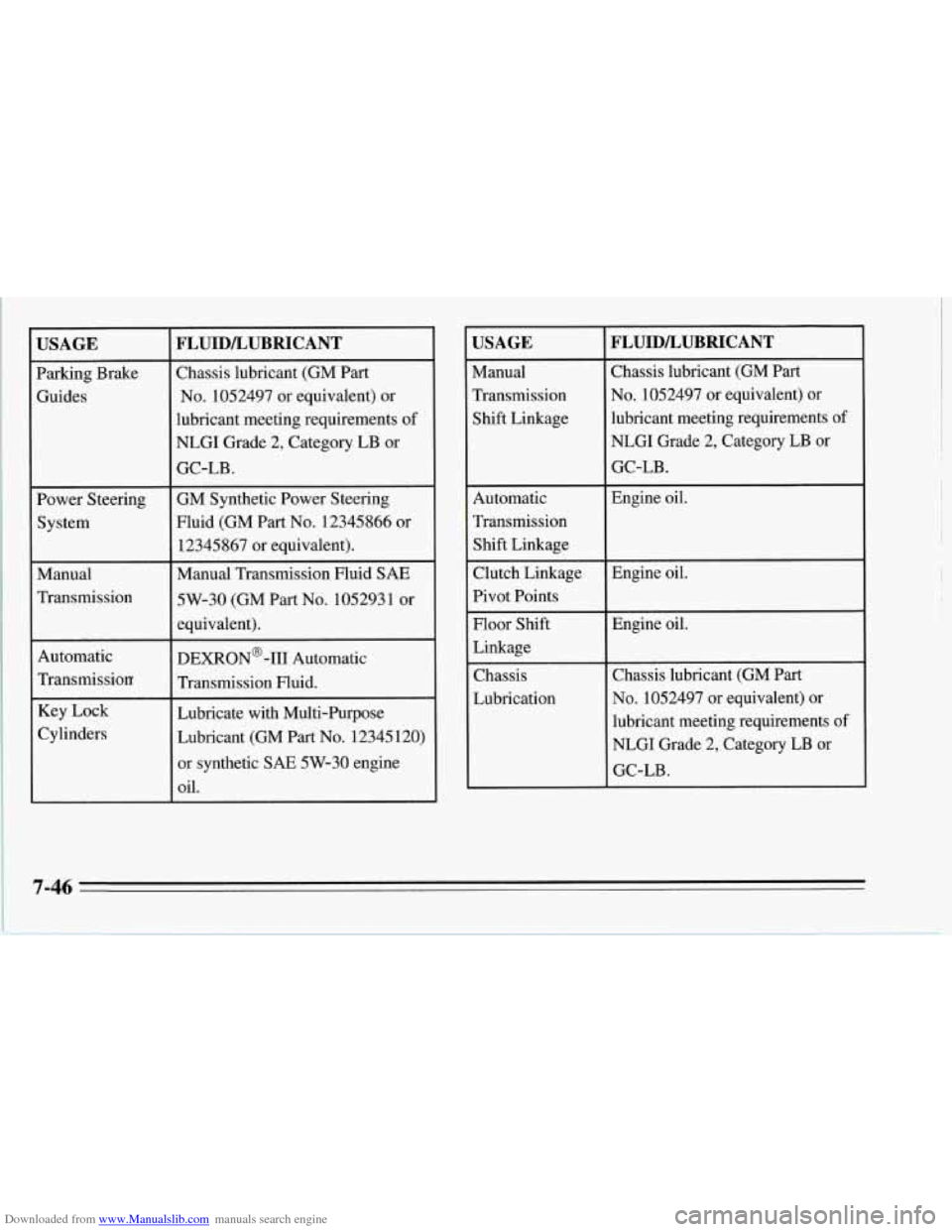
Downloaded from www.Manualslib.com manuals search engine USAGE
Parking Brake
Guides Power Steering
System
Manual
Transmission
Automatic
Transmission Key Lock
Cylinders
FLUIDLUBRICANT
Chassis lubricant (GM Part
No. 1052497 or equivalent) or
lubricant meeting requirements of
NLGI Grade
2, Category LB or
GC-LB.
GM Synthetic Power Steering
Fluid (GM Part
No. 12345866 or
12345867 or equivalent).
Manual Transmission Fluid SAE
5W-30
(GM Part No. 105293 1 or
equivalent).
DEXRON@-111 Automatic
Transmission Fluid.
Lubricate with Multi-Purpose
Lubricant (GM Part
No. 12345120)
or synthetic
SAE 5W-30 engine
oil.
USAGE
Manual
Transmission Shift Linkage
~~~
Automatic
Transmission
Shift Linkage
Clutch Linkage
Pivot Points
Floor Shift
Linkage
Chassis
Lubrication
FLUIDLUBRICANT
Chassis lubricant (GM Part
No. 1052497 or equivalent) or
lubricant meeting requirements of
NLGI Grade 2, Category LB or
GC-LB.
Engine oil.
Engine oil. Engine oil.
Chassis lubricant (GM
Part
No. 1052497 or equivalent) or
lubricant meeting requirements of
NLGI Grade 2, Category LB or
GC-LB.
7-46
Page 374 of 386
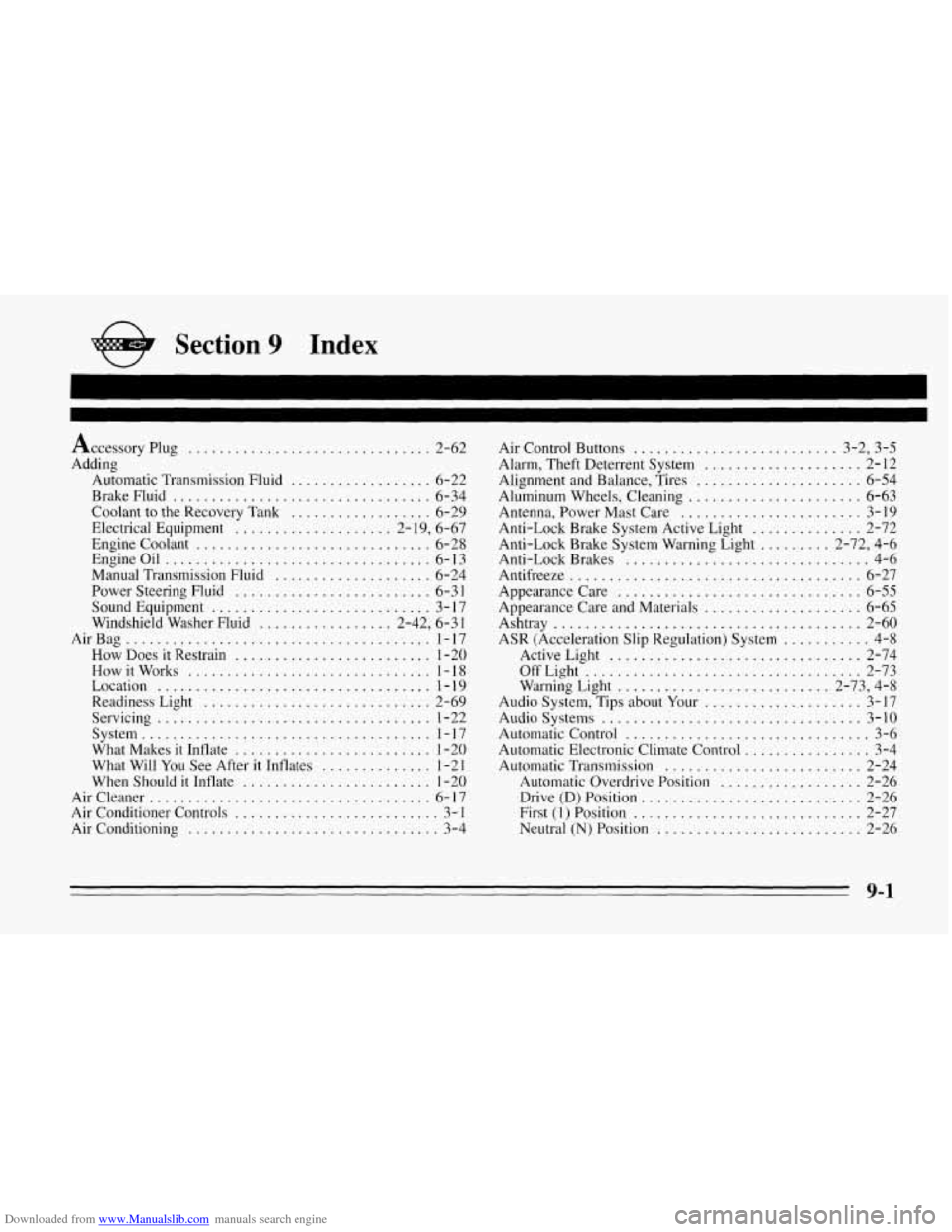
Downloaded from www.Manualslib.com manuals search engine Index
Accessory Plug ............. ............. 2-62
Adding Automatic Transmission Fluid
................ 6-22
Brake Fluid
...................... ...... 6-34
Coolant to the Recovery Tank
....... ........ 6-29
Electrical Equipment .................... 2- 19. 6-67
Engine Coolant
.............................. 6-28
Engineoil
.................................. 6-13
Manual Transmission Fluid
.................... 6-24
Power Steering Fluid
......................... 6-3 1
SoundEquipment ............................ 3-17
Windshield Washer Fluid
................. 2-42. 6-3 1
AirBag ....................................... 1-17
How Does it Restrain ......................... 1-20
How it Works ............................... 1 - I8
Location
................................... 1-19
Readiness Light
............................. 2-69
Servicing ................................... 1-22
System
..................................... 1-17
What Makes
it Inflate ......................... 1-20
What Will
You See After it Inflates .............. 1-2 1
When Should it Inflate ........................ 1-20
Air Cleaner
.................................... 6- 17
Air Conditioner Controls .......................... 3- 1
Air Conditioning ................................ 3-4 Air Control
Buttons
.......................... 3.2. 3.5
Alignment and Balance. Tires ..................... 6-54
Antenna. Power Mast Care
....................... 3-19
Anti-Lock Brake System Active Light
.............. 2-72
Anti-Lock Brake System Warning Light
......... 2.72. 4.6
Anti-Lock Brakes
............................... 4-6
Antifreeze ..................................... 6-27
Appearance Care
............................... 6-55
Appearance Care and Materials
.................... 6-65
Ashtray
....................................... 2-60
ASR (Acceleration Slip Regulation) System
........... 4-8
Active Light
................................ 2-74
OffLight
................................... 2-73
Warning Light
........................... 2.73. 4.8
Audio System. Tips about Your .................... 3-17
Audio Systems
................................. 3- IO
Automatic Control ............................... 3-6
Automatic Electronic Climate Control ................ 3-4
Automatic Transmission
......................... 2-24
Automatic Overdrive Position
.................. 2-26
Drive
(D) Position ............................ 2-26
First
(1) Position ............................. 2-27
Neutral
(N) Position .......................... 2-26
Alarm. Theft Deterrent
System
.................... 2-12
Aluminum Wheels. Cleaning
...................... 6-63
9-1